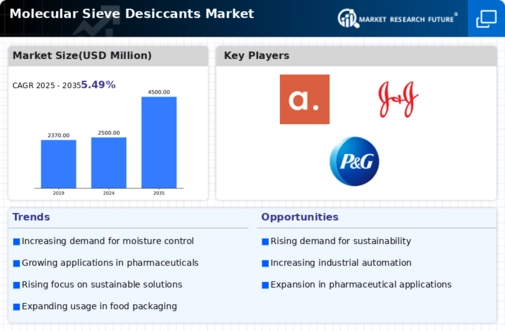Sustainability Trends
Sustainability initiatives are influencing the Global Molecular Sieve Desiccants Market Industry, as companies seek eco-friendly solutions for moisture control. The shift towards sustainable practices encourages the development of molecular sieves that are not only effective but also environmentally friendly. For example, some manufacturers are exploring bio-based desiccants that minimize environmental impact. This trend aligns with global efforts to reduce carbon footprints and promote sustainable manufacturing processes. As sustainability becomes a priority, the market for molecular sieve desiccants is expected to expand, reflecting a growing commitment to environmentally responsible practices.
Technological Advancements
Innovations in molecular sieve technology contribute significantly to the growth of the Global Molecular Sieve Desiccants Market Industry. Enhanced performance characteristics, such as improved adsorption capacities and regeneration capabilities, are being developed. For example, advancements in zeolite synthesis have led to the creation of more efficient desiccants that can operate under varying conditions. These technological improvements not only enhance product performance but also reduce operational costs for end-users. As a result, the market is expected to grow at a CAGR of 5.49% from 2025 to 2035, indicating a robust future driven by innovation.
Regulatory Support and Standards
The Global Molecular Sieve Desiccants Market Industry benefits from supportive regulatory frameworks that promote the use of desiccants in various applications. Governments and industry associations are establishing standards that encourage the adoption of effective moisture control solutions, particularly in sensitive sectors like pharmaceuticals and food processing. Compliance with these regulations not only ensures product safety but also fosters market growth. As industries strive to meet these standards, the demand for high-quality molecular sieve desiccants is likely to increase, further solidifying their role in moisture management.
Rising Demand in Various Industries
The Global Molecular Sieve Desiccants Market Industry experiences heightened demand across multiple sectors, including pharmaceuticals, food and beverage, and electronics. These industries require effective moisture control to maintain product quality and extend shelf life. For instance, in the pharmaceutical sector, molecular sieves are utilized to protect sensitive compounds from moisture, ensuring efficacy. As the global market expands, the demand for molecular sieve desiccants is projected to reach 2500 USD Million by 2024, reflecting a growing recognition of their importance in moisture management.
Increased Awareness of Moisture Control
There is a growing awareness among manufacturers and consumers regarding the detrimental effects of moisture on products, which drives the Global Molecular Sieve Desiccants Market Industry. Industries are increasingly adopting moisture control solutions to prevent spoilage and degradation. For instance, in the food industry, molecular sieves are employed to maintain the quality of dried fruits and snacks. This trend is likely to propel the market towards an estimated value of 4500 USD Million by 2035, as more sectors recognize the necessity of effective desiccants in preserving product integrity.














Leave a Comment